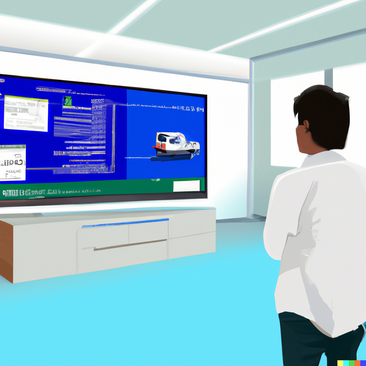Technology Goals
Jira, TFS, Confluence, GitHub, GitLab, and Miro are widely-used tools that support project management, version control, team collaboration, and task tracking in modern software development environments. These tools enable teams to plan, execute, and monitor projects across all stages, from initial brainstorming to deployment and beyond. Each of these platforms serves a specific role in ensuring efficient workflows, seamless collaboration, and smooth communication among team members.
- Jira: A popular project management tool used for tracking tasks, managing sprints, and following Agile methodologies. Jira enables teams to create and prioritize issues, manage backlogs, and run sprints, making it essential for Agile teams to track progress and meet project deadlines.
- TFS (Team Foundation Server): Now known as Azure DevOps, TFS is a Microsoft product that integrates source control, project management, and CI/CD pipelines. It allows teams to manage projects, track work items, and handle version control, making it ideal for organizations using the Microsoft ecosystem.
- Confluence: Confluence is a team collaboration tool that enables the creation and sharing of documentation, knowledge bases, and project plans. It integrates tightly with Jira, allowing teams to link project documentation to development tasks, improving transparency and knowledge sharing.
- GitHub: A widely-used platform for version control and code hosting, GitHub allows developers to manage source code, collaborate through pull requests, and automate workflows using CI/CD pipelines. GitHub is known for its powerful community and integrations with various tools, making it a hub for open-source and enterprise software development.
- GitLab: Similar to GitHub, GitLab provides version control, CI/CD, and project management features. GitLab distinguishes itself with its built-in DevOps capabilities, offering a unified platform for the entire development lifecycle, from planning to monitoring deployments.
- Miro: A visual collaboration tool used for brainstorming, project planning, and diagram creation. Miro’s digital whiteboard enables teams to collaborate in real time, visualize workflows, and map out ideas, enhancing creativity and clarity during the project planning stages.
In our projects, these tools are used to manage development cycles, collaborate across teams, track issues, and control code versions. By combining project management tools like Jira with source control systems like GitHub and GitLab, we ensure seamless integration between task management and development workflows.
Strengths of These Tools in Our Projects
Each of these tools brings specific strengths to the table, enabling efficient project management, collaboration, and version control:
- Jira: Jira’s robust issue tracking, customizable workflows, and Agile support make it a powerful tool for managing complex software projects. Teams can create user stories, manage sprints, and track progress in real time, ensuring that project goals are met efficiently.
- TFS/Azure DevOps: TFS integrates tightly with the Microsoft stack, offering seamless version control through Git or TFVC, built-in CI/CD pipelines, and comprehensive project management tools. For organizations already using Microsoft technologies, TFS is a natural choice for end-to-end project management and DevOps automation.
- Confluence: Confluence helps teams centralize project documentation, knowledge bases, and meeting notes, improving collaboration and transparency. Its integration with Jira allows teams to link tasks to relevant documentation, ensuring that all stakeholders have access to the necessary information.
- GitHub: GitHub is the go-to platform for version control, code collaboration, and community-driven development. Its pull request model simplifies code review, while its powerful integrations with CI/CD tools automate the testing and deployment process, ensuring that code is tested and deployed quickly.
- GitLab: GitLab’s strength lies in its all-in-one platform that covers the entire software development lifecycle. Its built-in CI/CD pipelines, project management features, and security tools provide a complete DevOps solution that streamlines development and operations processes.
- Miro: Miro enhances collaboration through its visual interface, allowing teams to brainstorm ideas, map out processes, and create diagrams that clarify project plans. Its real-time collaboration features make it ideal for remote teams or brainstorming sessions where creativity and team input are crucial.
Comparison with Other Tools
Compared to traditional project management tools like Trello or Asana, Jira offers more robust features for Agile development, such as detailed sprint management, backlog prioritization, and customizable workflows. Jira is better suited for development teams that follow Scrum or Kanban methodologies.
While GitHub and GitLab offer similar version control capabilities, GitLab stands out for its full DevOps pipeline support, providing built-in CI/CD, security, and monitoring tools. GitHub, meanwhile, has a stronger focus on community engagement and open-source collaboration, making it ideal for projects that require public exposure and contributions from developers worldwide.
TFS/Azure DevOps integrates more seamlessly with Microsoft technologies compared to GitHub or GitLab, offering native support for Windows Server, Active Directory, and Azure cloud services. This makes TFS ideal for organizations heavily invested in Microsoft’s ecosystem.
Real-world Applications in Client Projects
- Agile Project Management with Jira and Confluence: For a large-scale software development project, Jira was used to manage backlogs, sprints, and user stories. Confluence was employed to document requirements, architecture diagrams, and meeting notes, creating a transparent workflow where developers and stakeholders could easily access project details.
- Version Control with GitHub and GitLab: In a DevOps-driven project, GitHub was used to manage the source code, while GitLab’s built-in CI/CD pipelines automated the testing and deployment of the application. GitLab’s comprehensive monitoring tools provided insights into application performance post-deployment, ensuring continuous improvement.
- Brainstorming and Planning with Miro: For a product design phase, Miro was used to create user flow diagrams, wireframes, and sprint planning sessions. The visual collaboration made it easy for team members to contribute ideas, map out features, and align on the project vision.
Client Benefits and Feedback
Clients using these tools have reported significant improvements in team collaboration, project visibility, and delivery speed. A client in the fintech industry noted that Jira’s customizable workflows and Agile boards allowed their development team to stay on track and deliver features faster, while Confluence ensured that all project documentation was accessible and up-to-date.
In another case, a client praised GitHub’s pull request system for improving code review efficiency, while GitLab’s CI/CD features streamlined their release process. Miro’s collaborative whiteboard allowed a remote team to stay aligned during sprint planning, improving communication and creativity during the brainstorming phase.
Conclusion
Jira, TFS, Confluence, GitHub, GitLab, and Miro provide essential tools for managing projects, version control, and team collaboration in modern software development environments. These platforms ensure that teams can plan, track, and execute tasks efficiently while maintaining high levels of communication and coordination. Whether used for Agile project management, DevOps automation, or brainstorming sessions, these tools offer the flexibility and integration needed to drive successful project outcomes.








